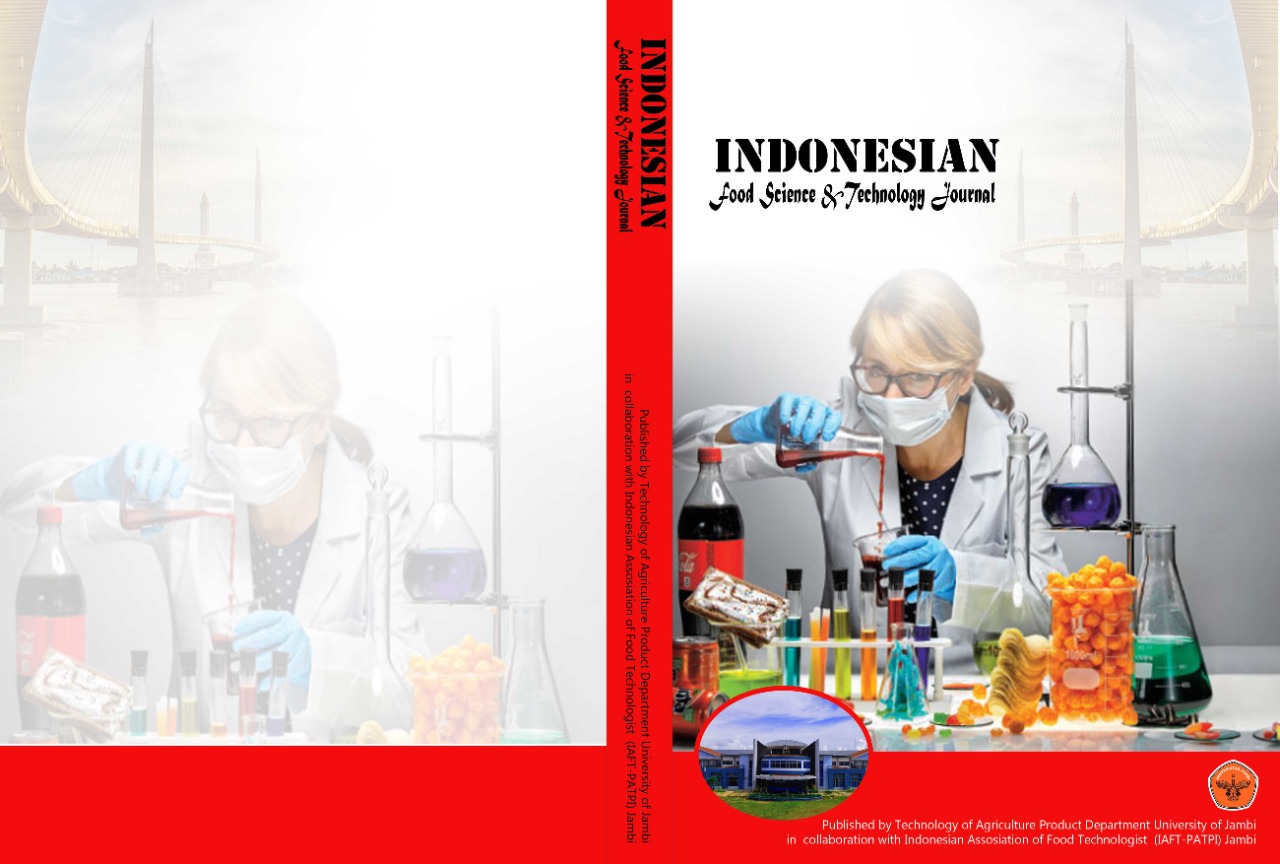Utilization Of Buckwheat, Proso Millet, And Amaranth For A Gluten-Free Cereal Bar
DOI:
https://doi.org/10.22437/ifstj.v5i2.17513Keywords:
Hardness, Pseudo cereals, Texture, WalnutAbstract
Four formulations of cereal bar were prepared using common buckwheat (55 parts), proso millet (15-30 parts), white amaranth (25-40 parts), walnut (27.5 parts), and jaggery (50 parts), by varying the proportions of proso millet and white amaranth in the ratio of 15:40, 20:35, 25:30 and 30:25. Roasted cereals and walnut pieces were mixed with jaggery syrup of 73.7° Bx and baked at 120° C for 20 minutes. The bars' proximate composition, mineral content (Ca, Fe and P) were evaluated and compared with the bar available in the market. The textural analysis and sensory profile of the bar were also evaluated. The crude fiber, calcium, and iron were significantly higher (p<0.05) in formulated bars compared to the market sample while energy and fat content were significantly higher (p<0.05) in the market sample. The formulated bars provided 440.31- 489.81kcal energy per 100 g, which qualified the product as a good energy-dense snack. From the textural analysis and sensory evaluation, Formulation C (common buckwheat-55, proso millet-25, white amaranth-30, walnut-27.5, and jaggery-50) was harder and preferred the most based on taste and overall acceptability. The research concludes the good potentiality of underutilized crops for cereal bar production.
Downloads
References
Bower, J. A., and Whitten, R. (2000). Sensory characteristics and consumer liking for cereal bar snack foods. Journal of Sensory Studies, 15(3), 327-345.
Lin, P. H., Miwa, S., Li, Y. J., Wang, Y., Levy, E., Lastor, K., and Champagne, C. (2010). Factors influencing dietary protein sources in the premier trial population. Journal of the American Dietetic Association, 110(2), 291-295.
Dutcosky, S. D., Grossmann, M. V. E., Silva, R. S. S., and Welsch, A. K. (2006). Combined sensory optimization of a prebiotic cereal product using multicomponent mixture experiments. Food Chemistry, 98(4), 630-638.
Sharma, C., Kaur, A., Aggarwal, P., and Singh, B. (2014). Cereal bars-A healthful choice A Review. Carpathian Journal of Food Science & Technology, 6(2), 29-36.
Ojha, P., Karki, R., and Subedi, U. (2020). Comparative Evaluation of Nutritional Value and Bioactive Components of Proso Millet, Foxtail Millet and Amaranth. Traditional Crop Biodiversity for Mountain Food and Nutrition Security in Nepal, 82-86.
Shrestha, J., Shrestha, R., Joshi, B.K., and Subedi, S. (2020). Future smart food crops in Nepal: A necessity for future food and nutritional security. Natural Resources and Sustainable Development, 10 (1), 46-56.
Green, P. H., and Jabri, B. (2003). Coeliac disease. The Lancet, 362(9381), 383-391.
Åžen, S. M., and Karadeniz, T. (2015). The nutritional value of walnut. Journal of Hygienic Engineering and Design, 11(18), 68-71.
Rao, J. P. V. K., Das, M., and Das, S. (2007). Jaggery-A traditional Indian sweetener. Indian Journal of Traditional Knowledge, 6(1), 95-102.
Ranganna, S. (1986). Handbook of analysis of quality control for fruit and vegetable products, 2nd ed. New Delhi: TATA Mcgraw-Hill pub. Co. Ltd
Kaur, R., Ahluwalia, P., Sachdev, P. A., and Kaur, A. (2018). Development of gluten-free cereal bar for gluten intolerant population by using quinoa as major ingredient. Journal of food science and technology, 55(9), 3584-3591.
Agbaje, R., Hassan, C. Z., Norlelawati, A., Rahman, A., and Huda-Faujan, N. (2016). Development and physico-chemical analysis of granola formulated with puffed glutinous rice and selected dried Sunnah foods. International Food Research Journal. 23 (2), 498-506
Covino, R., Monteiro, A. R. G., Silva, M. R., Marques, D. R., Benossi, L., and Monteiro, C. C. F. (2015). Manufacturing cereal bars with high nutritional value through experimental design. Acta Scientiarum. Technology, 37(1), 149-154.
Subedi, B., and Upadhyaya, N. (2019). Preparation and Quality Evaluation of Flaxseed Incorporated Cereal (Oat) Bar. Journal of Food Science and Technology Nepal, 11, 65-68.
Samakradhamrongthai, R. S., Jannu, T., and Renaldi, G. (2021). Physicochemical properties and sensory evaluation of high energy cereal bar and its consumer acceptability. Heliyon, 7(8), 1-9.
Constantin, O. E., and Istrati, D. I. (2019). “Functional Properties of Snack Bars,†in Functional Foods, V. Lagouri., Eds. Intech Open, pp 1-14
Mridula, D., Singh, K. K., and Barnwal, P. (2013). Development of omega-3 rich energy bar with flaxseed. Journal of Food Science and Technology, 50(5), 950-957.
Kim, E. J., Corrigan, V. K., Hedderley, D. I., Motoi, L., Wilson, A. J., and Morgenstern, M. P. (2009). Predicting the sensory texture of cereal snack bars using instrumental measurements. Journal of Texture Studies, 40(4), 457-481.
Carvalho, V. S., and Contiâ€Silva, A. C. (2018). Cereal bars produced with banana peel flour: evaluation of acceptability and sensory profile. Journal of the Science of Food and Agriculture, 98(1), 134-139.
Srebrenica, S. M., Goncalves, G. M. S., Ormenese, R. D. C. S. C., and Ruffi, C. R. G. (2016). Physico-chemical, sensory and nutritional characteristics of cereal bars with the addition of acacia gum, inulin, and sorbitol. Food Science and Technology, 36, 555-562.
Downloads
Published
How to Cite
Issue
Section
License
Copyright (c) 2022 Pravin Ojha, Anuska Adhikari, Utshah Manandhar, Sushma Maharjan, Sophi Maharjan

This work is licensed under a Creative Commons Attribution 4.0 International License.








